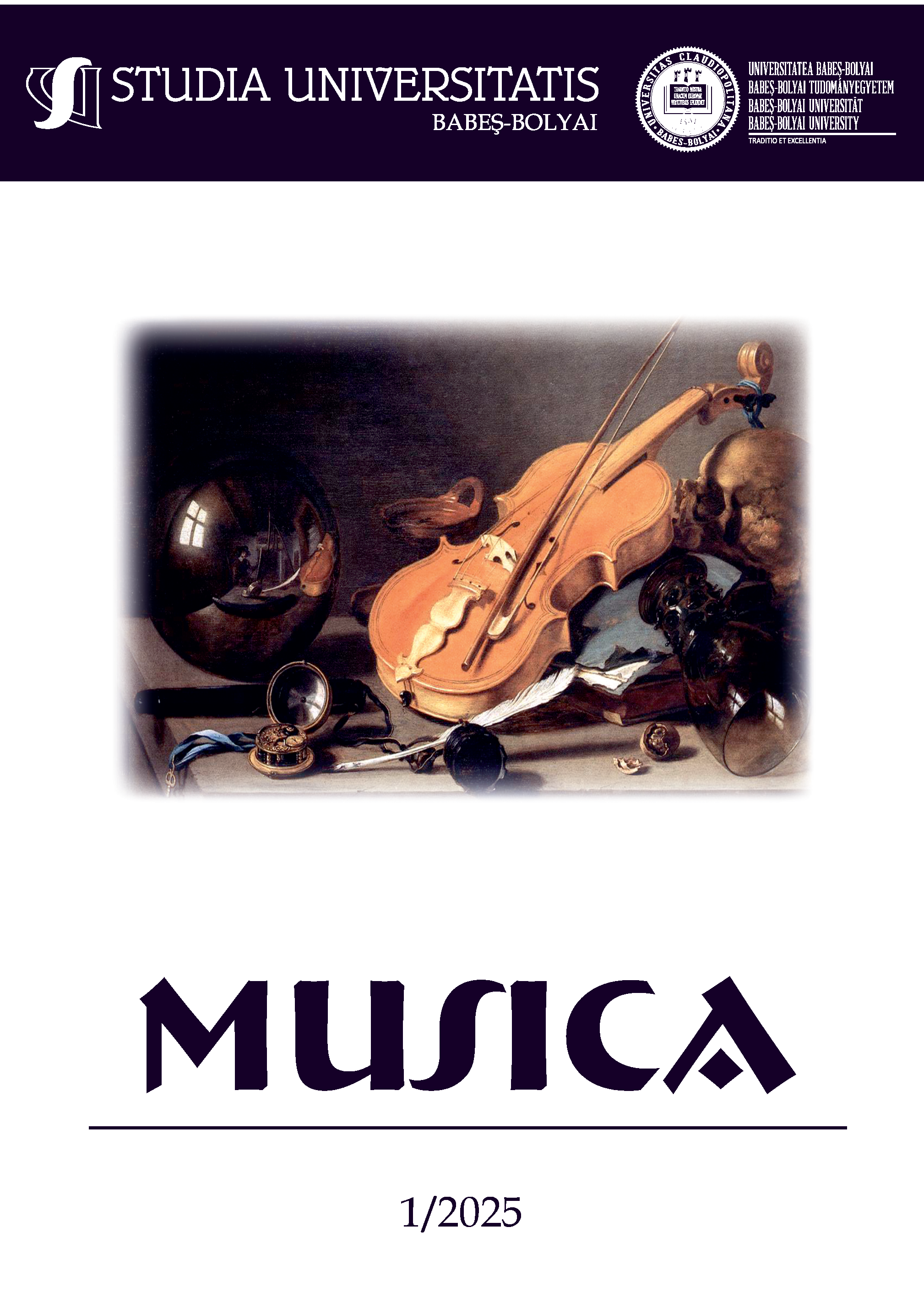The Prosomia of the Eight Modes According to Dimitrie Cunțanu
DOI:
https://doi.org/10.24193/subbmusica.2025.1.05Keywords:
prosomia, ecclesiastical music, Dimitrie Cunțanu, Transylvania, oralityAbstract
The aim of the present study is to analyse the prosomia recorded in the ecclesiastical musical tradition of Transylvanian, based on the collection of „Cântări bisericești” (Church Hymns), published by Dimitrie Cunțanu in 1890 in Vienna. The collection represents a significant attempt to standardize the Orthodox liturgical singing of the Metropolis of Transylvania, aligning itself with similar efforts previously undertaken in Wallachia and Moldova. By means of a historical-musicological research method, the present study highlights the context of the emergence of these melodic variants, the characteristics of the included prosomia, as well as their impact on contemporary musical practice. Prosomia, introduced as melodic interpretation models for hymns lacking their own musical line, constitute a point of intersection between the Byzantine tradition and the influences of Transylvanian folk music. The research reveals the presence of varied modal structures, including diatonic and chromatic modes, with a limited ambitus, a predominance of syllabic rhythm, and modal adaptations specific to the Transylvanian cultural-religious context. These features initially facilitated the integration of the prosomia into the musical repertoire but were later affected by the lack of continuity in the musical training of church singers and the preference for oral transmission of the hymns. In this context, the analysis of cadential formulas and modal particularities highlights an attempt to harmonize the Byzantine tradition with the musical and social realities of the Orthodox communities in Transylvania. The study highlights the fact that, despite their historical and pedagogical importance, Cunțanu’s prosomia have been gradually marginalized, being preserved only in a few parishes in southern Transylvania. The causes of this decline in visibility can be attributed to the lack of specialized singers, the formulaic structures, and melodic lines, distinct from the traditional system of the eight ecclesiastical modes. Additionally, the lack of interest in institutional frameworks to support the continuity of the tradition of prosomia and the preference for adapting hymn texts to the melodic structures of the resurrection troparia contributed to their diminishing role. The present study provides a detailed insight into the process of adapting the Byzantine musical tradition in Transylvanian space and the dynamics between orality, local cultural influences, and efforts to standardize prosomia. The conclusions provide a basis for future research on the mechanisms of adaptation and transformation of ecclesiastical singing and contribute to the understanding of the evolutionary dynamics of liturgical music in Transylvania, as well as the potential for revitalization of this musical heritage with identity and cultural value.
References
1. Alexandru, Maria şi Costas Tsougras, „On the Methodology of Structural Analysis in Byzantine and Classical Western Music - A Comparison”, in: Symposium “The Current State of Byzantine Musical Studies after 75 Years of MMB”, Copenhagen, 17th (June 2006), pp. 1-19.
2. Bouvi, Edmound, Poètes et mélodes: étude sur les origines du rythme tonique dans l’hymnographie de l’Église grecque, Impr. Lafare frères, 1886.
3. Cântarea liturgică ortodoxă din sudul Transilvaniei: cântarea tradiţională de strană în bisericile Arhiepiscopiei Sibiului (Orthodox Liturgical Chant in the South of Transylvania: traditional lectern chanting in the Sibiu Archdioceses), Vasile Grăjdian, Sorin Dobre, Corina Grecu, Iuliana Streza, Sibiu, Editura Universităţii „Lucian Blagaˮ din Sibiu, 2007.
4. Cântările bisericesti după melodiile celor opt glasuri al sf. biserici ortodoxe culese, puse pe note si aranjate de Dimitrie Cunţanu, (Church chants after the melodies of the eight voices of the Holy Orthodox Church, collected, put on notes and arranged by Dimitrie Cunțanu) Ediţia a II-a, Sibiu, 1925.
5. Chircev, Elena, Muzica românească de tradiție bizantină între neume și portativ (The Romanian Music of Byzantine tradition between absence and stave), ediție revizuită, vol. 2: Repertoriul liturgic românesc notat pe portativ în colecțiile de cântări bisericești din Transilvania și Banat (The Romanian Liturgic Repertoire noted on the stave in the collections of religious songs), Editura Risoprint, Cluj-Napoca, 2013.
6. Christ, W. et M. Paranikas, Anthologia graeca carminum christianorum; adornaverunt, 1871.
7. Ciobanu, Gheorghe, Studii de etnomuzicologie şi bizantinologie, (Studies in ethnomusicology and Byzantinology) vol. I, Editura Muzicală a Uniunii Compozitorilor, Bucureşti, 1974.
8. Giuleanu, Victor, Melodica bizantină. Studiu theoretic şi morphologic al stilului modern neo-bizantin, (Byzantine Melodica. Theoretical and morphological study of the modern neo-Byzantine style), Editura Muzicală, Bucureşti, 1981.
9. Giuleanu, Victor, Tratat de teoria muzicii, (Treatise on music theory) vol. 1, Editura Muzicală Grafoart, 2013.
10. Mocanu, Daniel, „Stylistic features of church music after dimitrie cunțanu, a default typology”, Studia UBB Musica, LXVIII, Special Issue 1, 2023 (p. 225 – 260).
11. Mocanu, Daniel, „The tradition of “cunțanu” church music between the orality and the uniformization trends”, in: Studia UBB Musica, LXIV, 2019, 1, pp. 291 – 314.
12. Popa, Valeriu, Școala Ortodoxă Română de Cântăreți bisericești Dimitrie Cunțan din Sibiu, (Dimitrie Cunțan Romanian Orthodox School of Church Singers from Sibiu), Anuarul II, 1927, 1937-1947, Suceava, 1947, p. 8-11.
13. Taft, Robert, „The structural analysis of Liturgical Units: an essay in methodology”, in: Beyond East and West: Problems in Liturgical Understanding, Washington, D.C. 1984, pp. 187-203
14. Vichente, Dăngulea, „Simeon Florea, fost cântăreț bisericesc la Biserica Sfântul Nicolae din Daneș”, (“Simeon Florea, former church singer at St. Nicholas Church in Daneș”) in: Actualitatea Dănășeană, iunie 2012, anul 1, nr. 3, p. 5.
15. Vintilescu, Petre, Despre poezia imnografică din cărțile de ritual și cântarea biseri¬cească, (On hymn poetry in ritual books and church chant) Editura Partener, Galați, 2006.
16. Wellesz, Egon, A history of Byzantine Music and Hymnography, Oxford at the Clarendon Press, 1998.
Downloads
Published
How to Cite
Issue
Section
License
Copyright (c) 2025 Studia Universitatis Babeş-Bolyai Musica

This work is licensed under a Creative Commons Attribution-NonCommercial-NoDerivatives 4.0 International License.



